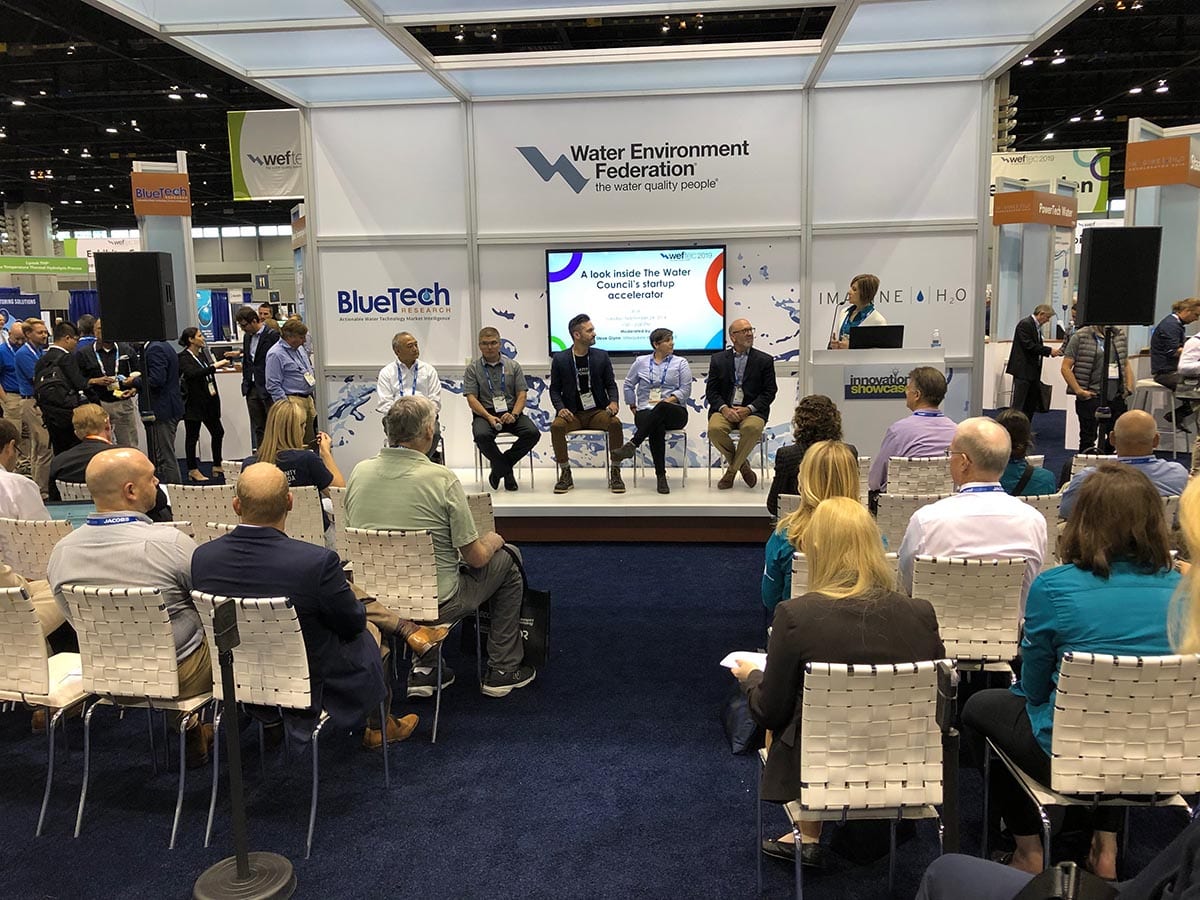
Students from UW-Platteville competed in the 2018 WEF Student Design Competition. From left, members include Joe LaPastora, Liz Ebert and Jessica Zemen. Not pictured is Erik Papenfus.
This week at the Water Environment Federation’s Technical Exhibition and Conference (WEFTEC), the largest annual water quality event in the world, two Wisconsin schools, UW-Milwaukee and UW-Platteville, competed against 20 schools in the WEF Student Design Competition. Winners were announced at the end of the competition day.
A place for future water professionals to innovate, exchange knowledge and connect with peers from all over the world, the student design competition promotes real-world design experience for students interested in pursuing careers in water and wastewater engineering and science. The competition consisted of two separate categories, a wastewater design competition and a water environment design competition.
To compete, individuals or teams of students prepared a design to help solve a water quality issue. Each team evaluated alternatives, performed calculations and recommended the most practical solution based on experience, economics and feasibility.
The UW-Milwaukee team competed in the wastewater design competition, which focused on design projects that traditionally address a challenge within a water resource recovery facility—for example, hydraulic capacity design, upgrades to existing treatment systems, or biosolids handling.
The project examined the integration of biogas water wash and struvite recovery process at the Milwaukee Metropolitan Sewerage District’s (MMSD’s) Jones Island wastewater treatment plant (WWTP). Team member Md Abul Bashar summarized the project in the official report:
Depending on the source, raw biogas from anaerobic digestion has a methane content of 50 to 60 percent, and 40 to 50 percent CO2 on molar basis. MMSD’s Jones Island WWTP (JIWWTP) uses the biogas supplied form South Shore WWTP in drying the Milorganite, a slow-release phosphate fertilizer. But with only 45 percent methane, the gas cannot be used for sophisticated purposes. To maximize its potential as an energy source, the methane content must be upgraded to its market competitor, natural gas. Among many methods, based on simulation result of Aspen Plus software and the pilot project, ‘High Pressure Water Scrubbing (HPWS)’ seems to be the best option. The process requires running the impure gas through pressurized water. Based on Henry’s Law, it is dissolved easily because of low partial pressure. The integrated process doesn’t need additional water or pressure, as it can use wastewater from JIWWTP and the gas is already supplied at an optimal pressure. It can also remove most of H2S, present as a trace amount in the biogas. Furthermore, struvite, a better-quality phosphorus fertilizer, can be recovered with adequate aeration and adding NaOH. From simulation result, the methane content can be improved up to 98.7 percent at a pressure of 150 PSI.
UW-Platteville competed in the environmental design competition, which is intended to include contemporary engineering topics—for example, stormwater management, water reuse, wetland construction, small systems, or distributed treatment projects in developing regions. The team consisted of Joe LaPastora, Jessica Zemen, Liz Ebert and Erik Papenfus. Their project explored a wastewater collection and treatment system for the community of Palmar Sur, Costa Rica.
According to the project report:
Palmar Sur is a rural community in Costa Rica that is looking for a long-term solution to their wastewater collection and treatment system. A sanitary solution is need for each neighborhood of Palmar Sur, including San Marcos, El Hangar and Zona Americana. The community has a current population of 1,985 people, with an expected growth rate of 50 people per year. The location of the treatment facility needs to be adequately size for anticipated flow, future growth, and infiltration and inflow (I/I) based on an annual precipitation of 3,900 mm/yr. Each neighborhood of Palmar Sur will be provided with a new wastewater collection system, increasing the pipe diameter from 15 cm to 20 cm (8 in). In addition, to adequately treat the wastewater, two treatment sites located northwest and southeast of the airport runway that divided the community were designed. The first treatment system, located in the neighborhood of Zona Americana, will contain a rock filter, aerobic lagoon and free water service wetland. The second treatment site, located in San Marcos, will contain a rock filter, a partially mixed aerated lagoon and a settling lagoon.
The student design competition teams are part of Global Water Stewardship (GWS), whose mission is to promote centralized wastewater treatment in developing countries, thereby improving public sanitation. GWS is a sister organization to the Central States Water Environment Association, an organization of water professionals in Illinois, Minnesota and Wisconsin.
As a sponsor for the event, Wisconsin had two judges participate in the competition. Dr. William Dougan, professor of management at UW- Whitewater, was a judge for the wastewater design competition, and Dr. Marcia Silva, assistant scientist and facility manager of the Water Technology Accelerator at the UW-Milwaukee School of Freshwater Sciences, was a judge for the water environment design competition.
The competition provided participants the opportunity to:
- network with students and industry leaders from across the world;
- gain professional experience and exposure;
- highlight their skills and enthusiasm for the water environment; and
- participate in WEFTEC activities tailored to students and young professionals.
Both the wastewater and environmental design competitions follow the same guidelines and scoring system.
Other teams participating in the design competition included:
- Case Western Reserve University
- George Mason University
- Manhattan College
- Montana State University
- National University of Singapore
- North Dakota State University
- Northeastern University
- Northern Arizona University
- Southern Methodist University
- University of British Columbia
- University of California – Irvine
- University of Colorado – Boulder
- University of Florida
- University of Guelph
- University of Idaho
- University of Kansas
- University of Notre Dame
- University of South Florida
- University of Tennessee – Knoxville
- Utah State University
For more information on the Student Design Competition, click here.






